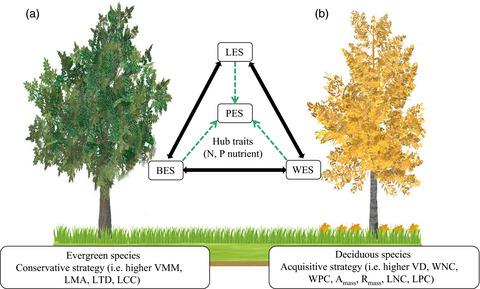Our official English website, www.x-mol.net, welcomes your
feedback! (Note: you will need to create a separate account there.)
A whole-plant economics spectrum including bark functional traits for 59 subtropical woody plant species
Journal of Ecology ( IF 5.3 ) Pub Date : 2021-10-22 , DOI: 10.1111/1365-2745.13800 Jinlong Li 1 , Xiaoping Chen 1, 2 , Karl J. Niklas 3 , Jun Sun 1 , Zhaoying Wang 1 , Quanlin Zhong 1 , Dandan Hu 1 , Dongliang Cheng 1, 2
中文翻译:

包括 59 种亚热带木本植物树皮功能性状的全植物经济学谱
更新日期:2021-10-22
Journal of Ecology ( IF 5.3 ) Pub Date : 2021-10-22 , DOI: 10.1111/1365-2745.13800 Jinlong Li 1 , Xiaoping Chen 1, 2 , Karl J. Niklas 3 , Jun Sun 1 , Zhaoying Wang 1 , Quanlin Zhong 1 , Dandan Hu 1 , Dongliang Cheng 1, 2
Affiliation

|
- The whole-plant economics spectrum (PES) refers to the trade-offs among the many plant functional traits that are commonly used as indicators of major adaptive strategies, thereby providing insights into plant distributions, ecosystem processes and evolution. However, there are few studies of what may be called the whole-PES that integrates bark, wood and leaf functional traits for different leaf types and growth habits (evergreen vs. deciduous species).
- To address this gap in our knowledge, 6 bark traits, 7 wood traits (including mechanical support and nutrient transport characteristics) and 12 leaf traits (including chemical, structural and physiological characteristics) of 59 representative subtropical woody species were examined using principal component analysis (PCA) to determine PES strategies.
- The economics spectra of bark (BES), wood (WES) and leaves (LES), and the entire PES indicated that major traits represent resource acquisition strategies and conservation strategies clustering on the opposite ends of the PCA axis. A significant correlation was observed among the 25 functional traits. The data indicated that N and P nutrient levels were at the hub of BES, WES, LES and PES interrelationships. Evergreen and deciduous species had different WES and LES, and thus PES resource acquisition strategies. With the exception of the BES, evergreen species clustered on the conservative side, whereas deciduous species clustered on the acquisitive side.
- Synthesis. The PES presented here informs our understanding of whole-plant responses to environmental differences, particularly regarding the role of N and P traits at the whole-plant level. It also reveals and further supports the notion that evergreen and deciduous species, respectively, manifest conservative and acquisitive strategies, further informing our understanding of species biodiversity maintenance.
中文翻译:

包括 59 种亚热带木本植物树皮功能性状的全植物经济学谱
- 全植物经济谱(PES)是指许多植物功能性状之间的权衡,这些功能性状通常用作主要适应策略的指标,从而提供对植物分布、生态系统过程和进化的洞察。然而,很少有关于整合不同叶子类型和生长习性(常绿与落叶树种)的树皮、木材和叶子功能性状的整体 PES 的研究。
- 为了弥补我们知识上的这一空白,我们使用主成分分析法对 59 个有代表性的亚热带木本植物的 6 个树皮性状、7 个木材性状(包括机械支撑和养分输送特性)和 12 个叶性状(包括化学、结构和生理特性)进行了检查。 PCA) 来确定 PES 策略。
- 树皮 (BES)、木材 (WES) 和树叶 (LES) 以及整个 PES 的经济光谱表明,主要性状代表资源获取策略和保护策略,它们聚集在 PCA 轴的两端。在 25 个功能性状之间观察到显着相关性。数据表明,N 和 P 养分水平处于 BES、WES、LES 和 PES 相互关系的中心。常绿和落叶树种具有不同的 WES 和 LES,因此 PES 资源获取策略不同。除 BES 外,常绿物种聚集在保守的一侧,而落叶物种聚集在获取的一侧。
- 合成。这里介绍的 PES 让我们了解了整株植物对环境差异的反应,特别是关于 N 和 P 性状在整株水平上的作用。它还揭示并进一步支持了常绿和落叶物种分别表现出保守和获取策略的概念,进一步了解了我们对物种生物多样性维护的理解。































 京公网安备 11010802027423号
京公网安备 11010802027423号